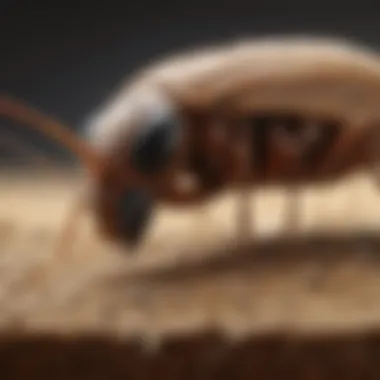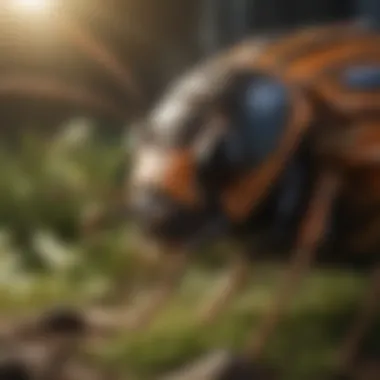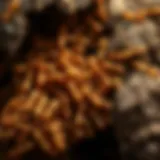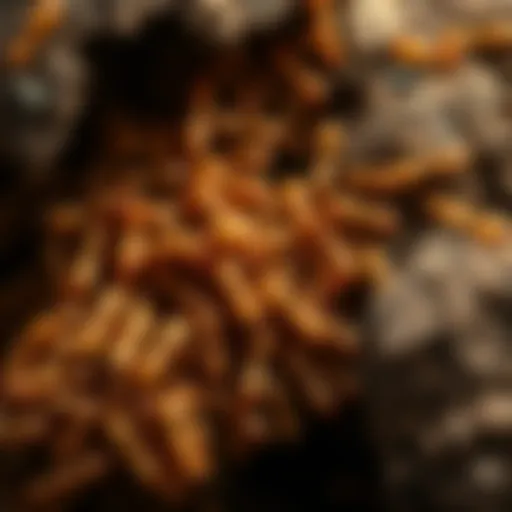Alias the Bug Man: Mastering Pest Control Strategies


Intro
Pest management is a crucial aspect of maintaining a healthy living environment. Understanding pests, their behavior, and effective control methods can help homeowners protect their property more efficiently. This article examines the role of 'the Bug Man' in pest control, focusing particularly on termites, which are notorious for their destructive nature. We will explore pest identification, prevention strategies, and treatment options, enabling homeowners to tackle infestations with knowledge and confidence.
Pest Identification
Pest identification lays the foundation for effective management. Knowing your enemy is significant before any treatment can take place. Here are some common pests and how to spot them:
Detailed Descriptions of Common Pests
- Termites: These are small, wood-eating insects that can cause severe structural damage. They often swarm in the spring, making them noticeable.
- Cockroaches: Cockroaches are resilient pests that prefer dark, moist areas. They can be identified by their flat bodies and long antennae.
- Ants: Ants have varied species within their ranks. They often form visible trails and can invade homes in search of food.
- Bed bugs: Small and elusive, bed bugs can be identified by bites or blood stains on sheets.
Signs and Symptoms of Infestations
Recognizing signs of infestations is crucial for prompt action. Common indicators include:
- Mud tubes along foundations for termites.
- Fecal droppings of cockroaches, resembling coffee grounds.
- Visible trails of ants led by worker ants.
- Bite marks and dark spots on bedding for bed bugs.
Prevention Strategies
Preventing pests is often more effective than curing an infestation. Here are some practical strategies:
Home Maintenance Tips for Pest Prevention
- Seal cracks and holes: Inspect the home for any openings in walls and foundations, sealing them properly.
- Proper garbage disposal: Store trash in sealed containers to avoid attracting pests.
- Regular cleaning: Keep surfaces clean to remove food residues that invite pests.
Natural Deterrents and Barriers
Consider using natural methods to repel pests:
- Diatomaceous earth: A non-toxic powder that can deter pests effectively.
- Essential oils: Oils like peppermint or tea tree oil can serve as effective repellents.
- Vinegar solutions: Vinegar can repel ants and other insects when used as a spray.
Treatment Options
Should an infestation occur, understanding treatment options is essential. Here is a brief overview:
Overview of Chemical vs. Natural Treatments
- Chemical Treatments: These often involve pesticides that target specific pests. They are generally fast-acting but require careful handling.
- Natural Treatments: Less toxic alternatives that can be safer for households, though often slower in effect.
Step-by-Step Guides for DIY Treatments
For those looking to handle pest control personally, here are general steps:
- Identify the pest: Use identification tips discussed earlier.
- Choose your treatment: Decide between chemical or natural options based on the severity of the infestation.
- Apply the treatment: Follow product instructions meticulously for effectiveness and safety.
- Monitor the area: Keep an eye out for resurgence or new signs to address promptly.
"Understanding pests and effective management is pivotal in safeguarding your home."
Closure
This exploration into the world of pest control provides vital information that homeowners can use to protect their spaces. By starting with proper identification, employing effective prevention techniques, and understanding treatment options, the fight against pests becomes manageable.
Foreword to Alias the Bug Man
The figure of the Bug Man occupies a unique and critical position in the realm of pest control. This section serves as a primer on what this title encompasses, the responsibilities associated with it, and its significance in managing pest-related issues. Understanding the role of the Bug Man is essential for homeowners, particularly those dealing with stubborn infestations or desiring preventative measures.
Definition of the Term
Alias the Bug Man refers to pest control experts familiar with various pest species, their behaviour, and the most effective management practices. This term encompasses more than just extermination; it indicates an expert's comprehensive understanding of the ecosystems in which these pests thrive. Pest control involves numerous activities—identification, treatment, prevention, and monitoring—making the Bug Man a versatile professional in this field.
Historical Context
The concept of pest control has much deeper roots than many realize. Historically, as civilization advanced, so too did the need to manage pests that threatened food security and health. Ancient Egyptians utilized natural remedies, while cultures worldwide developed varying techniques to keep pests at bay. Over time, pest control evolved significantly, going from rudimentary methods to sophisticated strategies employed by professionals today. The evolution of the Bug Man represents a merging of tradition and science, making them a reliable resource in modern pest management.
"Pest control is not just about eradication but encompasses an understanding of pests, their impact on human environments, and the development of sustainable solutions."
In the present day, with populations increasing and urban setups expanding, managing pests is more important than ever. The Bug Man stands at the forefront, equipping homeowners with knowledge and solutions essential for a pest-free environment.
Importance of Pest Control
Pest control is an issue that affects everyone, from single-family homes to large commercial establishments. This section emphasizes the significance of pest management in ensuring health and economic stability. Living in harmony with nature is desirable, yet when pests invade our spaces, they pose several threats that necessitate prompt action. An understanding of the importance of pest control can lead to healthier environments and more informed decision-making.
Impact on Health
Health remains the primary concern when discussing pest control. Pests such as rodents, cockroaches, and mosquitoes are not just annoying; they carry numerous diseases that can affect humans and pets alike. For instance, rodents are known carriers of hantavirus and salmonella, illnesses that can have severe consequences. Cockroaches can exacerbate asthma and other respiratory issues, particularly in children.
Preventing these pests from entering homes through effective pest management strategies is essential for safeguarding health. Regular inspections, effective sealing of entry points, and maintaining cleanliness can significantly reduce the risk of infestations. Eliminating pest breeding grounds and managing conducive conditions helps prevent health outbreaks associated with pests.
"Investing in pest control is an investment in your family's well-being."
Economic Implications
Beyond health concerns, the economic impact of pest infestations is significant. Property damage can lead to costly repairs and reduced property value. For instance, termites can cause extensive structural damage that may require thousands of dollars in remediation. This small insect can lead to major financial losses if left unaddressed.


Moreover, the presence of pests can threaten businesses, particularly in the food and hospitality industries. A single pest sighting can drive customers away and damage a business’s reputation. Studies indicate that companies investing in preventive pest management save money in the long run, avoiding the substantial costs of emergency treatments and loss of clientele.
Addressing pest problems proactively not only enhances the quality of life but protects economic interests. Sustainable pest control practices are a small price to pay for maintaining a healthy and economically sound environment.
Profile of the Bug Man
The topic of the Bug Man’s profile is essential to understanding the broader landscape of pest control. This section elucidates what makes professionals in this field invaluable, focusing on their qualifications, training, roles, and responsibilities. Such clarity helps homeowners and DIY enthusiasts recognize the importance of turning to skilled experts when necessary.
Qualifications and Training
A Bug Man, or pest control expert, needs a comprehensive set of qualifications and thorough training. The pathway often starts with a high school diploma or equivalent. Following this, aspiring Bug Men typically pursue specialized training programs, many of which are offered by community colleges or trade schools. These programs provide fundamental knowledge about pest biology, behavior, and environmental impacts.
Licensing is another key component. Most states require pest control technicians to be licensed, which involves passing a rigorous exam that tests one's knowledge on pest control practices and safety protocols. Continuing education is also critical. Pest management tactics evolve, necessitating up-to-date knowledge of the latest treatments and technologies.
In addition to formal training, hands-on experience under the supervision of seasoned professionals enhances skills. It equips them with practical knowledge about real-world scenarios. Understanding how to deal with various pests, like termites or bedbugs, is crucial in this profession.
Roles and Responsibilities
The Bug Man plays a vital role in maintaining a pest-free environment. Primary responsibilities include identifying pest types, assessing the extent of infestations, and developing tailored control strategies. They also interact with clients, educating them on pest management options, which helps demystify strategies and prevention methods.
Day-to-day duties typically encompass:
- Performins inspections of residential and commercial spaces.
- Implementing pest control treatments.
- Monitoring treatment results and making adjustments as necessary.
- Advising clients on preventive measures.
- Keeping detailed records of services provided.
The Bug Man should also be aware of the legal regulations governing pest control. Compliance with these laws is crucial to ensure safety for everyone involved. As a bridge between technical knowledge and real-life application, they serve a fundamental function in pest management. Through proper training and accountability, they promote a healthier and safer environment for us all.
Common Pests Managed
Understanding the variety of pests managed in pest control is fundamental to implementing effective management strategies. Pests can cause extensive damage to homes and can be harmful to health and well-being. The two most notable categories of these pests are termites and other common insects, both of which require distinct strategies for control.
Focus on Termites
Termites are often referred to as the "silent destroyers" because they can chew through wood, flooring, and even wallpaper undetected. This propensity for destruction makes them a significant concern for homeowners. According to the National Pest Management Association, termites cause billions of dollars in damages each year, highlighting their economic impact.
Prevention is key when dealing with termites. Their presence often goes unnoticed until extensive damage has occurred. Regular inspections by professionals can help identify colonies before they cause significant harm. Treatments may involve chemical barriers, baits, and even localized treatments tailored to the severity of the infestation.
"Effective termite management is crucial. Early detection can save homeowners from costly repairs."
Beyond damage, termites can also affect the structural integrity of a home, leading to more serious safety concerns. Homeowners must remain vigilant, as a small colony can quickly expand, contributing to larger infestations.
Other Common Insects
In addition to termites, several other insects represent common challenges in pest management. These include ants, cockroaches, bed bugs, and spiders. Each type of pest has its own behaviors and reproductive cycles, which influence the methods used for control.
- Ants are social insects that can quickly invade a space in search of food. They can be managed through baiting, exclusion methods, and proper sanitation.
- Cockroaches, known for their resilience, require targeted chemical treatments and thorough cleaning to eliminate breeding grounds.
- Bed bugs, once considered nearly eradicated, have made a comeback in recent years. Effective management often needs professional intervention due to their ability to hide and reproduce rapidly.
- Spiders, while often perceived as beneficial, can become a nuisance and sometimes pose risks, especially if venomous species are present.
Understanding the biology and behavior of these pests informs the strategies used to control them. A multifaceted approach combining inspection, exclusion, and treatment is often the most effective strategy in pest management.
Prevention Techniques
Prevention is a cornerstone of effective pest management, often determining the level of success in controlling infestations before they begin. Proactive strategies can save homeowners from costly damage and health risks associated with pest presence. Understanding how to prevent pest issues is essential for everyone, particularly those who wish to maintain a safe and hygienic living environment.
Physical Barriers
Physical barriers play a crucial role in preventing pests from entering homes. These include measures that physically block pests from accessing structures. Common examples are:
- Sealing Cracks and Crevices: Gaps around windows, doors, and foundation walls are entry points for many pests. Sealing these with caulk or foam insulation prevents pests from getting inside.
- Screens on Vents and Windows: Installing fine-mesh screens on windows and vents keeps flying insects out while allowing airflow.
- Door Sweeps: Using door sweeps blocks gaps beneath exterior doors, reducing entry points for crawling insects.
Additionally, creating a barrier in the landscape can hinder pests'. For instance, maintaining a clear area around the foundation free of debris, mulch, or tall grass limits hiding places for rodents and other pests.
Environmental Modifications
Environmental modifications focus on altering the surroundings to discourage pest infestations. These changes can be simple yet effective. Key considerations include:
- Managing Moisture: Most pests require water to survive. Address leaks and drainage issues around the home to reduce moisture that attracts pests such as termites and cockroaches.
- Landscape Management: Keep plants neatly trimmed and avoid overgrown vegetation near the house. This limits access points for pests and reduces their habitats.
- Proper Waste Management: Secure trash in containers with tight-fitting lids and remove waste regularly to prevent attracting rodents and insects.
Creating an inhospitable environment for pests is a strategic way to minimize their presence. Implementing these techniques not only helps in pest control but also promotes a healthier home atmosphere.
"Prevention-focused actions lower the reliance on chemical treatments and foster a sustainable approach to pest management."
In summary, prevention techniques serve as the first line of defense in pest control. By employing physical barriers and making environmental modifications, homeowners can significantly reduce the likelihood of infestations and protect their properties from potential damage.
Effective Treatment Options
Effective pest control treatment options are vital for managing pest populations effectively. Without proper treatment, infestations can escalate, leading to significant health risks and damage to property. This section aims to detail the primary treatment options available, focusing on their benefits and considerations that homeowners should bear in mind. Understanding these treatments helps in making informed decisions and ensures a conducive living environment.
Chemical Treatments
Chemical treatments have been a cornerstone of pest control for many years. These treatments typically involve the use of pesticides designed to eliminate pests swiftly. Here are some key points related to chemical treatments:
- Types of Pesticides: Chemicals can include insecticides, fungicides, and herbicides, each targeting specific types of pests. For instance, pyrethroids mimic natural insecticidal compounds found in chrysanthemum flowers.
- Application Methods: Chemicals can be applied through sprays, granules, or baits.
- Advantages: Chemical treatments often provide quick results and can effectively manage severe infestations. They are sometimes chosen when immediate action is necessary to protect homes from extensive damage.
- Safety Concerns: While effective, chemical treatments may pose risks to humans and pets. Thus, it's crucial to follow safety instructions and consider potential impacts on health and the environment.
- Environmental Regulations: Many regions have regulations governing the use of certain chemicals. Familiarity with local guidelines is essential to ensure compliance.
"The responsible use of chemical treatments can help maintain a pest-free environment while minimizing risks to human and animal health."


Natural Solutions
Natural solutions are gaining popularity among homeowners seeking alternatives to synthetic pesticides. These methods utilize naturally occurring substances to deter or eliminate pests, often emphasizing eco-friendliness and safety. Below are important aspects of natural solutions:
- Examples of Natural Treatments: Essential oils like peppermint and tea tree have been shown to repel various insects. Diatomaceous earth is another natural option that targets insects by dehydrating them.
- Non-Toxic Approach: Natural solutions often carry fewer risks to human health and the environment, making them appealing to individuals with small children or pets.
- Efficacy: Although natural treatments may be less potent than chemical counterparts, they can be effective, especially for minor infestations or preventative measures.
- Combination of Methods: Many professionals recommend combining natural and chemical treatments for a balanced approach. This strategy can optimize effectiveness while reducing reliance on chemicals.
- Sustainability and Integrated Pest Management (IPM): Emphasizing sustainability, natural solutions can be integrated into a broader IPM strategy, which aims to manage pest problems with minimal environmental impact.
Natural solutions can empower homeowners to manage pest issues responsibly and sustainably, ensuring the safety of their homes and loved ones.
The Role of Technology in Pest Management
Technology plays a vital role in modern pest management. With advancements in tools and practices, pest control has become more efficient and precise. By integrating technology, professionals can address pest issues in a targeted manner. This ensures that solutions are not only effective but also environmentally responsible. Homeowners can benefit significantly from this shift. Understanding how technology is applied in pest management can facilitate better decision-making.
Innovations in Pest Control Techniques
Innovations in pest control have transformed traditional methods. New techniques leverage data analytics, allowing pest control experts to assess infestations with great accuracy. Drones, for instance, have become valuable assets in surveying large areas. They provide aerial views of properties, helping locate infestations that may be hidden from ground view. This capability significantly reduces the time required for inspections.
Furthermore, smart traps that use sensors can now detect pest movement. The data collected can alert pest control operators of significant activity. This early warning system enables quicker responses to potential outbreaks. These innovations mark a shift towards proactive pest management rather than reactive measures.
Use of Monitoring Devices
Monitoring devices are essential in the contemporary landscape of pest management. These tools provide continuous observation of pest activity in specific areas. For example, electronic rodent monitoring systems track movements and population dynamics. This real-time data allows for timely interventions, reducing the risk of larger infestations.
Moreover, using apps or online platforms, homeowners can control these devices remotely. This connectivity supports greater engagement in pest management efforts. It empowers homeowners to take action based on solid data rather than waiting for a technician's visit. Monitoring devices thus bridge the gap between professional pest control and homeowner involvement, enhancing overall effectiveness.
"Technology not only improves pest management but also makes it more accessible for homeowners, allowing for direct involvement in the process."
Myths about Pest Control
Understanding the myths surrounding pest control is vital for homeowners and those interested in managing pest-related issues effectively. Misconceptions can lead to ineffective measures, unnecessary costs, and potential harm to both humans and the environment. This section addresses common myths, aiming to provide clarity and factual information. By debunking these myths and clarifying terminology, readers can make informed decisions about pest management practices.
Debunking Popular Misconceptions
- All pesticides are harmful: Many people think that all pesticides pose a threat to health and the environment. In reality, there are numerous products designed to minimize impact while effectively controlling pests. Understanding the difference between products is essential.
- DIY methods are always sufficient: While some pest problems can be managed at home, others require professional expertise. Not all infestations are the same; hence, calling a pest control expert may be necessary.
- Pests only invade dirty homes: This view suggests that cleanliness completely prevents pest invasions. However, pests can be attracted to various environments, including clean homes. Factors such as food access and shelter play significant roles.
- One treatment will solve everything: Many believe that a single treatment will eradicate all pests. In truth, pest management often requires multiple approaches over time to ensure lasting results.
- Natural methods are ineffective: Some assume that only chemical treatments are dependable. However, many natural solutions can be quite effective when used correctly, serving as viable alternatives.
"Understanding misconceptions in pest control can lead to better management practices and a healthier living environment."
Understanding Terminology
The terminology related to pest control can often be confusing. Here are essential terms that homeowners should know:
- Pest: Any organism that is harmful, destructive, or annoying, especially to crops, livestock, or human health.
- Integrated Pest Management (IPM): A comprehensive approach that combines prevention, monitoring, and control techniques to manage pest populations sustainably.
- Chemical Control: The use of pesticides to eliminate or control pests. This method must be used responsibly to minimize risks.
- Biological Control: Using natural predators or parasites to manage pest populations, creating a balance without chemicals.
- Cultural Control: Adjusting farming practices or home habits to reduce pest attraction or survival, such as proper sanitation or habitat modification.
By understanding these key terms and debunking myths, homeowners can take effective steps towards proper pest management. This awareness fosters a proactive attitude, enabling better decision-making for a pest-free environment.
Legal and Ethical Considerations
The legal and ethical considerations regarding pest control are vital for both professionals in the field and homeowners seeking assistance. Understanding these elements helps ensure safe practices that conform to regulations and reflect ethical responsibility. It is crucial not just for compliance, but also for maintaining public trust.
Regulations in Pest Control
Pest control is regulated at multiple levels, including federal, state, and local jurisdictions. Various organizations oversee these regulations, with the Environmental Protection Agency (EPA) being a prominent body in the United States. The EPA establishes guidelines for pesticide safety, ensuring that any chemicals used pose minimal risk to humans and the environment.
Homeowners should be aware that only licensed professionals can handle certain pest control treatments. This licensing varies by state and covers a range of criteria, from required training to testing and certification. The regulations often encompass the appropriate use of chemicals, the necessity of following specific application methods, and adherence to labeling instructions.
Compliance with local codes is also critical. Many cities have ordinances that govern pest control measures to protect community health and safety. Ignoring these laws can lead to fines, legal actions, or damage claims from affected neighbors. Homeowners are encouraged to request evidence of licensing when hiring pest professionals, ensuring that they abide by regulations.
Environmental Impact
The environmental impact of pest control practices is a significant concern in today's society. The use of certain pesticides can lead to contamination of waterways and harm non-target species. Therefore, ethical pest control prioritizes methods that are environmentally friendly.
Adopting integrated pest management (IPM) practices reflects a responsibility towards ecological balance. IPM combines various strategies, including biological control, habitat manipulation, and the use of resistant varieties. The goal is to minimize chemical inputs while effectively managing pest populations.
Furthermore, the ethical practice of pest control involves educating clients on the potential impacts of pest management decisions. This includes discussing both benefits and risks associated with various treatment options. Homeowners should be encouraged to think critically about their choices, fostering a more informed approach to pest control.
Ethical pest control is not only about compliance with regulations; it is about fostering a sustainable and respectful relationship between humans and the environment.
Awareness of the legal and ethical frameworks in pest control prepares homeowners to engage with professionals responsibly. By understanding the rules and considering the environmental implications, it leads to informed choices that reflect an understanding of the responsibilities we have towards our environment.
Diy Solutions vs Professional Help
Deciding between do-it-yourself (DIY) pest control strategies and engaging professional services is crucial for homeowners. This choice carries implications not only for the effectiveness of the treatment but also for safety and cost-effectiveness. Understanding when to tackle pest problems independently or when to consult experts can lead to better outcomes in managing infestations.
When to DIY
Many homeowners opt for DIY solutions when faced with minor pest issues. This approach can prove beneficial in several specific instances:
- Minor Infestations: If the problem is still small, like a few ants or spiders, simple traps and baits can often suffice.
- Cost Savings: DIY methods typically cost less than hiring a pest control professional. This is a strong motivator for many house owners.
- Availability of Resources: With plenty of pest control products available in stores or online, many people find it easy to address common pests like cockroaches or bedbugs at home.
- Knowledge and Experience: If a homeowner has prior experience in pest management, they may feel competent to handle the situation themselves.
However, it is essential to approach DIY pest control with caution. Improper methods can worsen the infestation or lead to other issues such as safety hazards from chemical exposure.
When to Call in a Professional
There are certain scenarios where seeking professional help is essential. Homeowners should be aware of these situations:


- Severe Infestations: If insects or rodents are pervasive, professionals have the necessary tools and expertise to address large-scale infestations effectively.
- Health Risks: Certain pests pose serious health risks, like termites or rodents. A professional can allevate potential health hazards and better address the concern.
- Specialized Knowledge: Professionals are often trained in the latest pest control methods and have access to advanced equipment that is not available to the public.
- Time Constraints: Homeowners who cannot dedicate enough time to perform effective measures may prefer hiring a professional for peace of mind.
In summary, the decision to pursue DIY solutions or hire professionals depends on various factors, including the scale of the infestation, personal expertise, and potential health risks. Each approach has its distinct advantages and disadvantages, which should be carefully evaluated to ensure the best results in pest management.
Cost Considerations
Understanding cost factors is crucial in pest control. Pest management involves various expenses, and knowing these can help homeowners make informed decisions. Costs can be influenced by the type of treatment, the level of infestation, and the specifics of a property. In this section, we will examine treatment costs and discuss the importance of long-term investments in prevention.
Analyzing Treatment Costs
Homeowners often face a dilemma when selecting pest control services. Different methods come with different price tags. For instance, chemical treatments can range significantly depending on the toxicity, effectiveness, and application. Natural solutions might offer a lower upfront cost but could require more treatments over time. Factors to consider include:
- Extent of the infestation: Larger infestations necessitate more extensive and expensive treatments.
- Type of pest: Specific pests, like termites, might incur higher costs due to the specialized methods required for elimination.
- Service provider's expertise: Professionals with higher qualifications may charge more, yet they often provide a better guarantee of results.
These costs can vary not just by the pest but also by region and the service provider's reputation.
Long-term Investment in Prevention
Investing in prevention is as vital as addressing current pest problems. Many homeowners overlook this aspect, focusing instead on immediate solutions. However, the cost of preventative measures often outweighs the costs associated with remedial treatments in the long run. Consider the following benefits of preventive strategies:
- Reduced likelihood of infestations: Regular preventative treatments can deter pests before they become a significant issue.
- Lower overall costs: Spending on prevention can save significant money by avoiding expensive extermination services later.
- Increased property value: A pest-free home is more attractive to potential buyers, enhancing resale value.
"Preventive measures are an investment in peace of mind, helping you avoid costly outbreaks down the line."
While the initial costs of preventive measures can seem steep, they represent a proactive approach that can safeguard both finances and health.
Case Studies
Case studies in pest control provide valuable insights by showcasing real-world applications of pest management methods. They illustrate the practical challenges and successes encountered by professionals in the field. This section focuses on how these narratives can inform and guide homeowners and DIY enthusiasts in making informed decisions about pest management. Understanding the nuances of specific cases allows for more effective strategies, ultimately leading to healthier living environments.
Success Stories
Success stories from pest control case studies often highlight effective strategies for managing specific pests, particularly termites. For instance, a homeowner in a suburban neighborhood discovered a termite infestation in her basement. After a thorough inspection by the Bug Man, who identified the nature of the infestation, an integrated pest management approach was adopted. The solution included targeted chemical treatments and thorough sealing of entry points. This not only eradicated the termites but also prevented future invasions. The homeowner reported a significant increase in peace of mind, knowing her home was well protected.
These narratives serve as motivation for individuals who may be facing similar pest challenges. They illustrate that with the right professional help and dedicated preventive measures, success is achievable.
- Key components of the success stories include:
- Detailed assessments of the pest situation
- Clear communication between the Bug Man and homeowner
- Strategic planning for both immediate and long-term pest management
Lessons Learned
Case studies also offer crucial lessons learned from past experiences in pest control. For example, one major takeaway from a series of case studies focused on widespread termite treatment in urban areas is the necessity of regular inspections. Many homeowners failed to conduct regular checks, which led to more extensive infestations.
As a result, the importance of preventive education became evident. Homeowners need to be aware that minor signs of pests can escalate into larger issues if not addressed promptly. Moreover, consistently updating knowledge about pest behavior and treatments can improve outcomes for residents.
In summary, the lessons learned from pest control case studies reinforce the importance of proactive measures, regular inspections, and effective communication between pest control professionals and homeowners. They underline the need for ongoing education in pest management, emphasizing responsibility among homeowners in maintaining pest-free environments.
Future Trends in Pest Control
The landscape of pest control is evolving rapidly. As society progresses, understanding future trends in pest management becomes crucial. These trends influence how pest control is perceived and executed. By staying aware of these changes, homeowners can make informed decisions regarding their pest management strategies.
Emerging Technologies
Today, technology is reshaping many industries, including pest control. Innovations like artificial intelligence and machine learning are revolutionizing how pests are detected and treated. Smart sensors can monitor pest activity in real time, providing data that can predict infestations before they occur.
Drones are also entering the pest control realm. These devices can cover large areas quickly, inspecting properties for signs of pests without the need for ladders or scaffolding. This not only improves efficiency but also reduces risk for pest control professionals.
Non-toxic treatments are gaining momentum. Homeowners increasingly prefer methods that are not harmful to the environment. Manufacturers respond by creating pest control products that prioritize safety while remaining effective. The focus on sustainability is likely to grow. Integrating these technologies may become more mainstream, making pest management both safer and more efficient.
Shifting Consumer Attitudes
Consumer attitudes towards pest control are changing. Awareness of health and environmental issues drives homeowners to question traditional methods. This skepticism is influencing demand for greener pest control solutions. Homeowners now prioritize services that demonstrate a commitment to safety. As a result, pest control companies adapt, emphasizing eco-friendly practices.
More consumers are also leaning towards preventative measures rather than reactive solutions. This shift involves understanding the biology of pests and implementing long-term strategies.
"Education is key. Homeowners today want to know how pest control works and what it entails."
Shifting attitudes reflect a deeper understanding of the significance of pest control. It is no longer viewed merely as a response to infestations but as an ongoing responsibility. Homeowners recognize that consistent monitoring is essential to maintaining a pest-free environment. The pest control industry must acknowledge these attitudes, evolving to meet the needs of a more informed consumer base.
In summary, the trends in pest control emphasize technological advancements and changing consumer preferences. By embracing these changes, pest control can become more effective, sustainable, and aligned with the values of modern society.
The End
In any discussion on pest management, the conclusion holds significant weight. It is where the information and arguments presented come together, reinforcing the importance of the article's topic. Here, we reflect on the key elements discussed and highlight the benefits that come from understanding pest control practices. The role of 'the Bug Man' is essential, not only in treatment but also in promoting preventive strategies that homeowners can implement.
As we have discussed, effective pest control is not merely a reaction to an infestation. It is about fostering a proactive mindset. The careful management of pests like termites can save homeowners considerable amounts of money and stress. Furthermore, understanding the science behind pest control empowers individuals to make informed decisions, whether they choose professional help or decide to tackle the issue themselves.
The ongoing evolution in pest management techniques, alongside emerging technologies, underscores that this field is dynamic. Both consumers and professionals need to stay abreast of changes to effectively manage pests.
Summary of Key Points
- Role of the Bug Man: Central figure in pest control, especially regarding termites.
- Preventive Strategies: Importance of physical barriers and environmental modifications to keep pests at bay.
- Treatment Methods: A variety of options are available, including chemical treatments and natural solutions.
- Technological Support: Innovations play a vital role in monitoring and managing pest control.
- Myth Busting: Dispelling common misconceptions helps in making informed choices.
- Legal and Ethical Considerations: Pest control must conform to regulations to ensure environmental safety.
The Ongoing Responsibility of Pest Management
Pest management is not a one-time event; it is an ongoing responsibility for homeowners. Regular inspections can help catch potential infestations early. Education about local pests and their behavior contributes to better preventive measures.
The relationship between homeowners and pest control professionals should be collaborative. Homeowners should feel confident in voicing their concerns and understanding the methods used for pest management. The scope of pest control extends beyond treatment to encompass ecological implications and regulations.
The future of pest management relies on a combination of human knowledge and technological advancement. With rising consumer awareness and expectations, maintaining a pest-free environment will demand adaptability and continuous learning from both homeowners and pest control experts.



